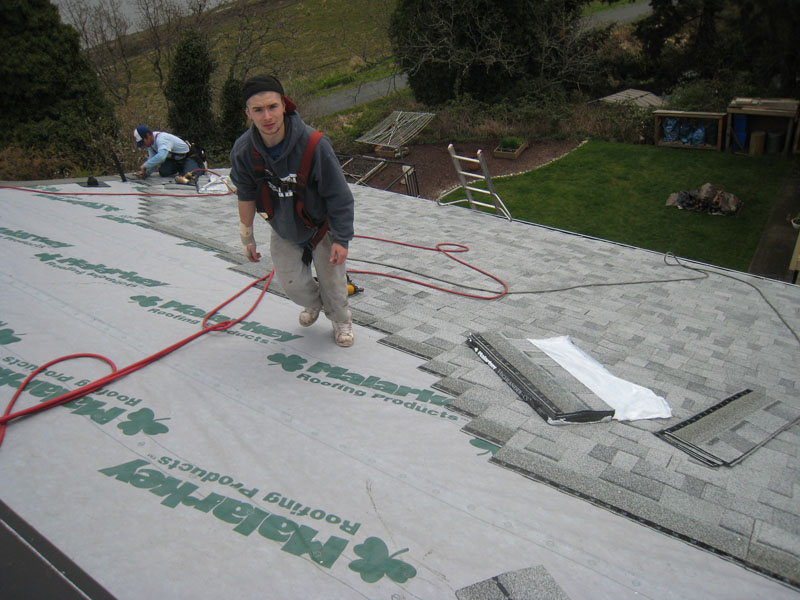When it comes to roofing, there are a lot of decisions to make, from the type of shingles to the color of the flashing. But one choice homeowners often overlook the type of underlayment to use.
Choosing the right underlayment can mean the difference between a roof that lasts for decades and one that needs constant repairs. In this article, we’ll examine the advantages and disadvantages of synthetic and felt underlayments.
What Is Roofing Underlayment?
Roofing underlayment is a layer of material that goes directly on top of the roof deck and underneath the primary roofing material, such as shingles. The roof underlayment’s primary purpose is to provide an additional layer of protection for the roof.
It does this by serving as a barrier against water, moisture, and other potential sources of damage.
Roofing underlayment is typically made of either synthetic or felt materials, and it is available in various thicknesses and weights. The type of underlayment can vary depending on the specific roofing application, as well as factors such as climate, personal preferences, etc.
Synthetic underlayment
Synthetic underlayment, also known as high-performance underlayment, is a newer and more advanced type of roofing underlayment. It is typically made of polypropylene or polyester materials.
Additionally, this roofing underlayment is designed to provide superior protection against moisture, UV radiation, and other types of damage.
PROS
· Durability
Synthetic underlayment is extremely durable and long-lasting, lasting up to 50 years. It is resistant to tears, punctures, and other types of damage that can occur during installation or due to extreme weather conditions.
· Ease of installation
Synthetic underlayment is lightweight and easy to handle, making it faster and easier to install than traditional felt underlayment. It can be easily cut to size and requires fewer fasteners.
As a result, its installation process requires little time and labor costs.
· Moisture resistance
Synthetic underlayment is highly resistant to moisture and can prevent water from seeping through the roof deck.
· UV protection
Synthetic underlayment is designed to provide superior protection against UV radiation, which can cause shingles to deteriorate over time. This can help extend the roof’s life and reduce the need for frequent repairs.
CONS
· Cost
Synthetic underlayment is generally more expensive than traditional felt underlayment. This is a significant factor for homeowners and contractors on a tight budget.
· Lack of familiarity for some contractors
Synthetic underlayment is a newer product; some contractors may be less familiar with it or hesitant to use it.
· Potential slipperiness
Some synthetic underlayment products may be more slippery than felt underlayment. This can cause safety concerns during installation.
Felt underlayment
Felt underlayment, also known as asphalt felt or tar paper, is a traditional type of roofing underlayment that has been in use for many decades. It is typically made of organic or fiberglass materials and is available in various weights and thicknesses.
PROS
· Affordability
Felt underlayment is generally more affordable than synthetic underlayment. It is, therefore, a popular choice for homeowners and contractors on a tight budget.
· Flexibility
Felt underlayment is flexible and can conform to the shape of the roof deck. Hence, it is a versatile option that you can use with a wide range of roofing materials.
· Compatibility with a wide range of roofing materials
You can use felt underlayment with most roofing materials, including asphalt shingles, metal roofing, and clay tiles.
CONS
· Susceptibility to moisture damage
Felt underlayment is not as resistant to moisture as synthetic underlayment. As a result, it may be more prone to damage if exposed to moisture over an extended period.
· Shorter lifespan
Felt underlayment has a shorter lifespan than synthetic underlayment. It must be replaced more frequently, especially in harsh weather conditions.
·
· Heavier and bulkier than synthetic options
Felt underlayment is heavier and bulkier than synthetic underlayment. This makes it more difficult to handle and install, especially on larger roofing projects.
Which Underlayment Is Best For Your Project?
Deciding which type of underlayment to use for your roofing project will depend on various factors.
Here are some of the factors to consider when choosing between synthetic and felt underlayment:
1. Climate
Live in an area with harsh weather conditions, such as heavy rain or extreme temperatures. Synthetic underlayment may be better since it protects against moisture and UV radiation.
2. Budget
Feeling underlayment may be a more affordable option if you are working on a tight budget. You should, however, note that it may require more frequent replacement over time.
3. Roofing material
Synthetic underlayment is more compatible with roofing materials, such as metal roofing. Meanwhile, felt underlayment is suitable with a wider range of roofing materials.
4. Contractor preference
Some contractors may prefer one type of underlayment over another based on their experience and familiarity with the products.
Conclusion
If you’re planning a roofing project in the Vancouver area, consider working with Shoreline Roofing. Our experienced team of professionals can help you select the right underlayment and roofing materials to ensure a high-quality, long-lasting result.
Call us at (250) 413-7967 or Contact us today to schedule a consultation and learn more about our roofing services.

